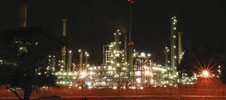

Chevron began marketing product in South Africa in 1911. It now markets the product under the Caltex brand, which began as a partnership between Chevron and Texaco in 1936. The 100 000 barrel per day Cape Town refinery produces gasoline, diesel, jet fuel, LPG and asphalt. Chevron South Africa initiated a project to replace the existing Centum XL DCS at the refinery with Yokogawa’s CS3000 hardware and upgrade the control network to VNet/IP.
Project background
The basis for this project was to ensure the refinery’s DCS retains high reliability and the required availability. The risk of availability of the existing control system was increasing due to its age which could result in increased maintenance costs and unplanned plant shutdowns or production losses.
The intent was to replace the existing Centum XL control stations, which have been in service in excess of 15 years, with the latest Yokogawa CS3000 hardware and upgrade the control network to a faster and more efficient VNet/IP.
In June 2008, Yokogawa SA was appointed as the principal contractor with overall responsibility for the project.
Project summary
The main objective of the project was to upgrade the DCS online. This required hot cutovers during the switchover from the old system to the new. The hot cutover ensured there was no downtime on the plant and that all instruments and controls could be tested immediately after the cutover.
Structured, formal project and engineering procedures were developed and were followed to ensure all the process requirements were implemented and all the risks were mitigated. The execution procedure culminated in a thorough risk assessment process involving all key stakeholders.
Reliability and maintenance, advanced control, construction and operations representatives were assigned to the project to ensure all Chevron’s requirements were met.
Prior to the hot cutover of each control station, the current program was re-configured for CS3000. A formal process was followed to ensure all the control logic and functionality was retained and complied with the software configuration standard that was developed for the project.
After the approval of the design, the Yokogawa CS3000 hardware was installed into the DCS panels and the panels were acceptance-tested. The hot cutover process was carried out on an individual I/O point basis. Field wiring was transferred point by point from the old DCS to the new DCS; simultaneously the existing configuration (program) was disabled and the new configuration activated. Control valves were bypassed until the controller was successfully cutover.
Success factors
The key challenge in this project was to cutover the refinery live, without disrupting production. Yokogawa achieved this on time and within budget. The following factors contributed to this success:
* The experience of the team members.
* The team work between Yokogawa and the Chevron personnel assigned to the project.
* Good communication between team members during the cutover process.
* Developing and following a structured approach.
* Completing a thorough risk assessment process that ensured all risks were mitigated.
* Continual evaluation and improvement of processes based on lessons learnt.
* Yokogawa’s enabling technology.
Project manager, Phillip Venter, says that having the entire Yokogawa team in one location on site improved the efficiency of the team and coupled with each team member’s personal commitment to the project it was a pleasure to work with Yokogawa.
Project Statistics
* Hardwired I/O cutover – 7132.
* FCSs cutover – 24.
* I/O modules – 61.
* Nodes – 123.
* System cables – 805.
* Terminal boards – 499.
* Domains upgraded to Vnet/IP – 3.
* Engineering stations – 3.
* Human interface stations – 30.
* Incident free man-hours on site to date – 50 584.
* Number of loss incidents – 0.
| Tel: | +27 11 831 6300 |
| Email: | [email protected] |
| www: | www.yokogawa.com/za |
| Articles: | More information and articles about Yokogawa South Africa |

© Technews Publishing (Pty) Ltd | All Rights Reserved